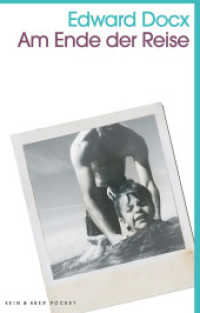Full Description
Inspired by Nathaniel Hawthorne's own experience as a member of the famous Brook Farm Community, which the author describes in his preface as the "most romantic episode" in his life, The Blithedale Romance is one of the most engaging and complex of Hawthorne's novels. Recounting the hopeful formation and slow fragmentation of a reform-minded socialist community in antebellum Massachusetts, the novel has increasingly preoccupied commentators on American literature and culture over the last few decades.
The editors' new introduction helps the reader to negotiate Blithedale's literary difficulties by offering a detailed reflection on the main problems confronted by past and present interpreters of the novel. Appendices expand on the central historical theme of reform, highlighting the novel's references to women's emancipation, antislavery, and Utopian socialism.
Contents
Acknowledgements
Introduction
Nathaniel Hawthorne: A Brief Chronology
A Note on the Text
The Blithedale Romance
Appendix A: Hawthorne on Brook Farm, Reform, and Social Change
Nathaniel Hawthorne, Selected Letters to Sophia Peabody (April 1841 to June 1842)
From "The Hall of Fantasy" (1843, 1846)
From "Earth's Holocaust" (1844, 1846)
From "The Old Manse" (1846)
From The Scarlet Letter (1850)
Appendix B: Universal Reform and Associationism
From George Ripley, Letter to the Church in Purchase Street (1 October 1840)
From "'The Memory and Example of the Just,' A Sermon, Preached on All Saints' Day, to the First Church, by Its Minister, N.L. Frothingham. Boston, 1840." Christian Examiner (January 1841)
From Ralph Waldo Emerson, "Chardon Street and Bible Conventions," The Dial (July 1842)
From Ralph Waldo Emerson, "Lectures on the Times," The Dial (July 1842)
From Ralph Waldo Emerson, "New England Reformers" (1844)
From Albert Brisbane, "Association and Social Reform," The Boston Quarterly Review (April 1842)
From Charles Lane, "Brook Farm," The Dial (January 1844)
From Andrew Jackson Davis, The Principles of Nature, Her Divine Revelations, and a Voice to Mankind (1847)
Appendix C: Woman Emancipating, Woman Emancipated
Pastoral Letter of the General Association of Massachusetts (28 June 1837)
From Sarah Grimké, Letters on the Equality of the Sexes, Addressed to Mary S. Parker, President of the Boston Female Anti-Slavery Society (1838)
From Letter III: The Pastoral Letter of the General Association of Congregational Ministers of Massachusetts
From Letter XII: Legal Disabilities of Women
From Catharine E. Beecher, An Essay on Slavery and Abolitionism, with Reference to the Duty of American Females (1837)
From William Lloyd Garrison, "Letter to the Boston Female Anti-Slavery Society," The Liberator (16 October 1840)
Margaret Fuller, Selected Comments on Woman
From "Leila," The Dial (April 1841)
From Woman in the Nineteenth Century (1845)
Sophia Ripley, "Woman," The Dial (January 1841)
From Orestes Brownson, "Miss Fuller and Reformers," Brownson's Quarterly Review (April 1845)
From Oneida Community [John Humphrey Noyes], "Bible Argument; Defining the Relations of the Sexes in the Kingdom of Heaven" (1849)
From Theodore Parker, "Sermon of the Public Function of Woman" (1853)
Appendix D: The Fugitive Slave Law and Northern Anti-slavery
From the US Constitution, Fugitive Slave Act (1850)
From Horace Mann, "Speech to the Massachusetts Convention in Opposition to the Fugitive Slave Law" (1851)
Caroline W. Healey Dall, "Amy. A Tale," Liberty Bell (1849)
Antislavery Emblems: "Am I Not a Woman and a Sister?"
Josiah Wedgwood Antislavery Medallion (1787)
Typefounder's Cut from The Liberator (1832)
Kneeling Slave with Dame Justice, from the Cover Page of Authentic Anecdotes of American Slavery (1838) by Lydia Maria Child
Needlecase Stamped with Antislavery Emblem
Appendix E: Harriet Hosmer, Zenobia in Chains (1859)
Appendix F: Contemporary Reviews of The Blithedale Romance
From "Contemporary Literature of America: 'The Blithedale Romance,'" The Westminster Review (October 1852)
Edwin Percy Whipple, Graham's Magazine (September 1852)
Works Cited and Recommended Reading







